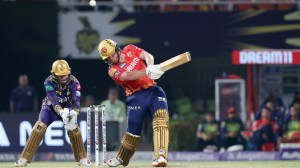- India
- International
Plain talk: Now for some real science
Five scientists look at the science we missed at the Indian Science Congress.
 (Source: Illustrated by C R Sasikumar)
(Source: Illustrated by C R Sasikumar)While an ‘ancient plane’ stole all the attention, The Sunday Express spoke to five scientists to look at the science we missed at the Indian Science Congress
Naba Mondal, project director of Tamil Nadu-based India-based Neutrino Observatory (INO), Tata Institute of Fundamental Research, Mumbai
“The session on ‘Holistic Approach to Atomic Energy’ deserved more attention as it deliberated on India’s energy requirements and where they can come from. The paper on ‘India’s Future Needs of Electricity’ by S P Sukhatme, professor emeritus at IIT Bombay, projected the country’s energy requirement, 50 years from now, when the population is expected to stabilise,” says Mondal, who presented a paper on ‘Neutrinos and INO’. In his presentation, Sukhatme said India should aim for a per capita power generation of 4,000 kWh/year to meet the requirements of a growing population.
Sib Sankar Roy, CSIR-Indian Institute of Chemical Biology, Kolkata
“Professor N R Jagannathan from AIIMS, New Delhi, described the role of Magnetic Resonance Imaging (MRI) and Magnetic Resonance Spectroscopy (MRS) in cancer. These techniques cover a broad range of applications from fast non-invasive anatomical measurements to the study of tissue physiology and metabolism in in vivo condition,” says Roy. The technique helps determine the concentration and relative levels of metabolites, which, in turn, is useful for characterising normal and cancer tissues and their response to therapy. “Both MRI and MRS being non-invasive can be used for repetitive measurements on same subject. Therefore, proper application of these techniques can be used for early diagnosis of cancer,” says Roy, who presented a paper on the growth factor-mediated signalling events in ovarian cancer.
Mayank Vahia, National coordinator of Astronomy Olympiad, Homi Bhabha Centre for Science Education, Mumbai

The paper on ‘Archaeobotany and Old and New World Relations’ by Dr K S Saraswat from Birbal Sahani Institute of Palaeobotany, Lucknow, showed that Indians and other parts of Asia had links with America thousands of years before explorer Christopher Columbus discovered the routes to the Western Hemisphere in the 15th Century. “This was a significant paper in which Saraswat stated that pineapple, maize, sunflower, peanuts, custard apple, tobacco and other such plants and food grains, which are native to America and other European countries, existed in India. In ‘Tools, Techniques and Time: Multiple Approaches to the Study of South Asia’s Pre-Historic Past’, a paper presented by Dr Shanti Pappu, director of Sharma Centre for Heritage Education at Chennai, the researcher spoke about excavations at 200 sites around Attirampakkam, 60 km west of Chennai, found that humanoids inhabited India between 1.07 Ma (megaannus, equivalent to one million years) and 1.7 Ma. The findings revealed this is much earlier than the previously estimated age of humanoids in India, closer to the age of oldest known humanoid sites in Africa,” says Vahia, who presented a paper on ‘Future Labs for Archaeology’.
Aniket Sule, academic coordinator, Astronomy Olympiad, Homi Bhabha Centre for Science Education, Mumbai
Sule, who was coordinator for the session on ‘Challenges to Education in Modern India’, says the session on mega science projects in astronomy, especially the paper on ‘Square Kilometre Array: the Radio Telescope Mega Project’ by Professor Yashwant Gupta, deserved more attention. In his presentation, Gupta said India is one of the 10 countries in the world which will play a vital role in establishing the world’s largest and most sensitive radio telescope, the Square Kilometre Array, and that India has designed the ‘telescope manager’, which is like the nervous system of the project. Gupta’s presentation said the project would bring in development in multiple technology areas such as signal transport, signal processing, computing, software and data archiving.
Sunil Mukhi, scientist at the Indian Institute of Science Education and Research (IISER), Pune
“In his presentation, TIFR’s Prof Naba Mondal spoke of the technological spin-offs from the India-based Neutrino Observatory (INO) project, with industries being asked to manufacture parts of the Iron Calorimeter Detector (ICAL) to study the properties of neutrinos,” said Mukhi, who gave a talk on ‘String Theory and Quantum Gravity’. The other exciting presentation, according to Mukhi, was the one by Srinivas Krishnagopal on ‘Laser Plasma Accelerators’. “During the talk, he displayed a new method of propulsion through which one can also have a table top accelerator in a small lab. These were great ideas that can turn into breakthrough science,” says Mukhi.
Inputs from Tabassum Barnagarwala
Apr 26: Latest News
- 01
- 02
- 03
- 04
- 05








































